
Recently on a flight from Japan, with not much to do but sketch or get up to use the restroom, I got to thinking about the restroom symbol. Why does this pictogram say ?women and men?? Shouldn?t it simply say ?restroom?? It imposes stereotypes that make way-finding illogical and validate discrimination. So shouldn?t we improve it?
Here is the outcome, along with some of my thoughts on the process.
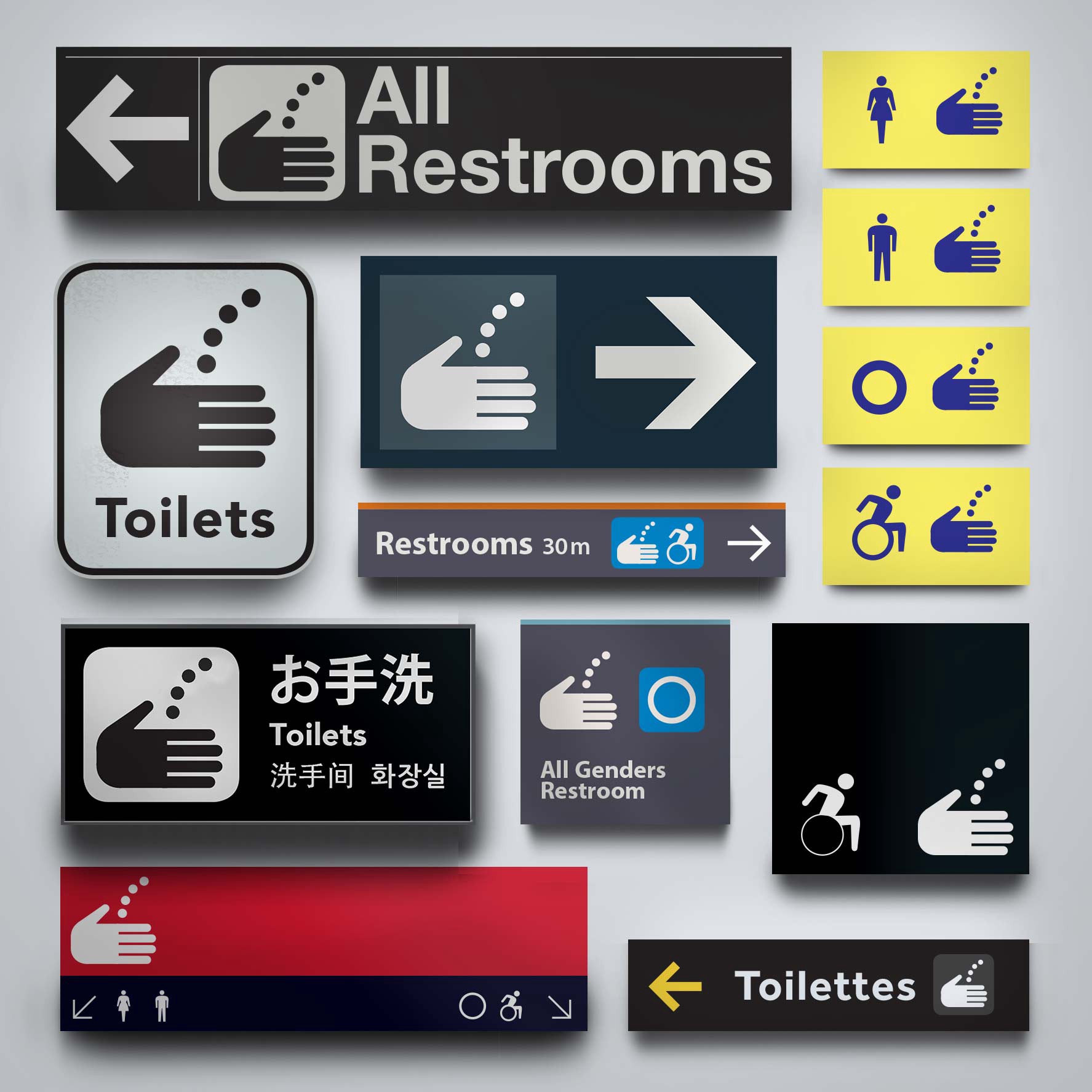

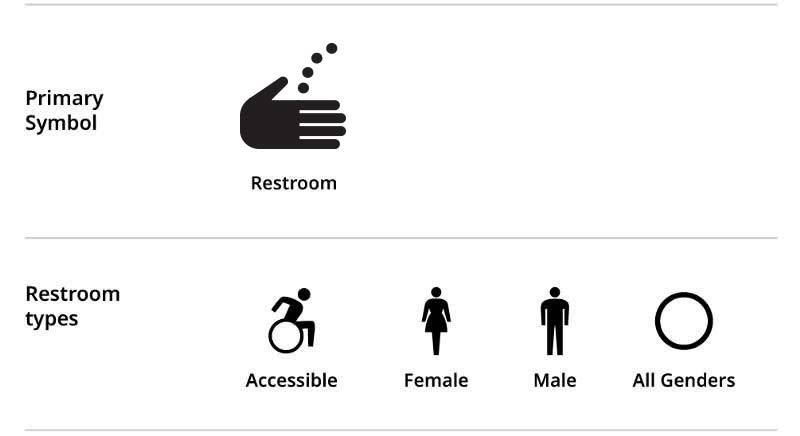 All types of restroom are equal: more logical and more inclusive. All Genders is represented by an open circle.
All types of restroom are equal: more logical and more inclusive. All Genders is represented by an open circle. The symbol is designed to be a harmonious member of the international family of symbols
The symbol is designed to be a harmonious member of the international family of symbols It is designed to be legible at small scales
It is designed to be legible at small scales
What?s wrong with ? ?
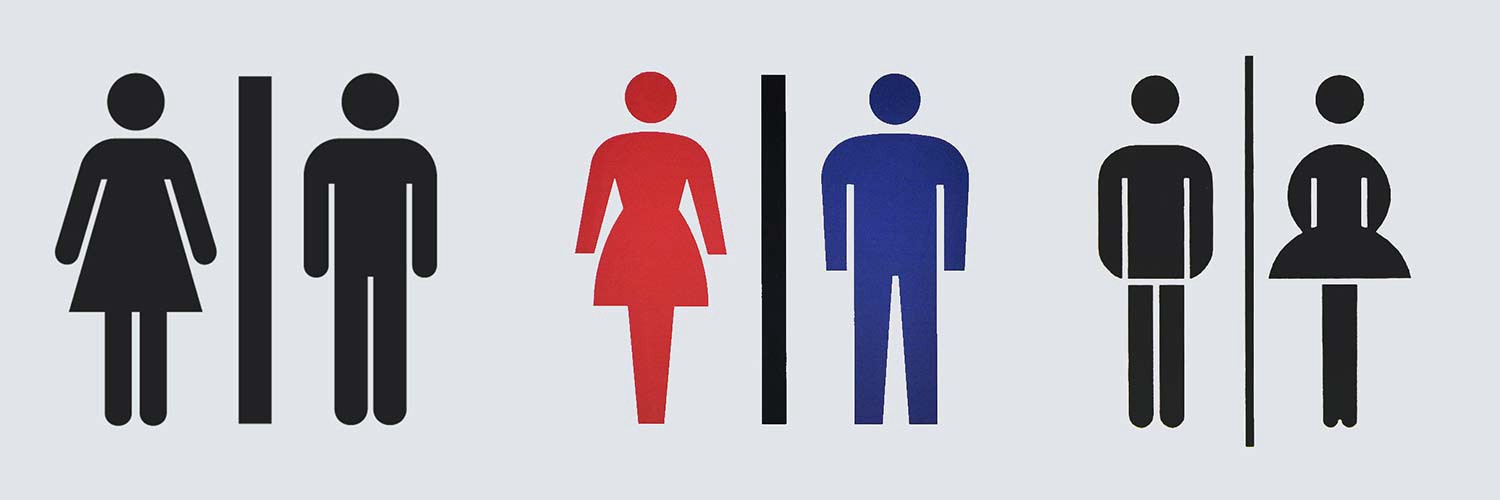 Left to right: U.S. Department of Transportation standard restroom symbol (designed by the American Institute of Graphic Arts with Roger Cook and Don Shanosky, 1974); The Japanese Industrial Standard restroom symbol (designers unknown); Restroom symbol for the 1972 Munich Olympic Games (designed by Otl Aicher)
Left to right: U.S. Department of Transportation standard restroom symbol (designed by the American Institute of Graphic Arts with Roger Cook and Don Shanosky, 1974); The Japanese Industrial Standard restroom symbol (designers unknown); Restroom symbol for the 1972 Munich Olympic Games (designed by Otl Aicher)
The stick woman and man have become about as universal as a sign could hope to be. Every day they guide us to restrooms the world over. And, like any true celebrity, they have been styled by a long list of big-name designers. But this power couple have undeniably overstepped their bounds.
The Woman/Man symbol doesn?t say ?restroom??it says ?female/male separated space.?
Living with an imperfect symbol is unfortunate. But, like countless other quirks of language, it?s possible to make do. The more serious problem lies in the underlying message.

The premise of the ?woman/man? symbol is that bathrooms are primarily for people who conform to gender norms. This message promotes exclusion and discrimination.
For trans and gender non-conforming people, using the restroom can be a fearful experience. They face abuse and violence and often feel forced out of using public restrooms altogether.
In a 2015 survey of American trans people:
- 12 percent of respondents reported being verbally abused in a public bathroom in the past year.
- 1 percent said they had been physically assaulted in a bathroom in that year.
- 32 percent said they limited how much they ate or drank so that they wouldn?t have to use a public restroom.
- 8 percent reported having contracted a urinary tract infection or kidney infection as a result of avoiding bathroom use.
The Man|Woman restroom symbol teaches that gender is an intrinsic and essential consideration when using a restroom. In fact, this symbol would have you believe that being a man or a woman is the defining characteristic of the restroom. Experience tells us this is not true. This symbol asserts that men and women are universally identified by the shape of their bodies and the clothes they wear. But cultures around the world have many styles of clothing, and many people don?t conform to the gender expectations within their culture.
Significant semiotic systems of a culture lock in the status quo. The mythology that surrounds a society?s crucial signs displays the world as it is today ? however chaotic and unjust ? as natural, inevitable and eternal. ? Roland Barthes
How did we end up with ? ?
As symbols, the woman and man make sense in two specific cases:
- together: to indicate ?gender segregated space.?
- separately: to indicate ?men? or ?women.?
So how did they break out of their natural home in space and meaning to become the ruling symbol of restrooms?
For the designer who created them, the man and woman probably seemed like an obvious choice. Gender separation has been accepted practice in most public restrooms for at least a century. This norm is reflected in laws that mandate separate restrooms in offices, schools and public places. These laws dictate that the separate restrooms be clearly identified using signs. Furthermore, restroom separation happens in busy or official public spaces ? the kinds of places that need signs.
But most restrooms are not gender-separated. We share the restroom at home, on trains and aeroplanes. It?s not unusual to share restrooms in offices, cafs, convenience stores or, in fact, just about anywhere.
These private or smaller restrooms aren?t usually subject to standardised systems of visual language. Symbol designers focus on airports, stadiums or shopping malls. The humble everyday restroom is unlikely to factor into their designs ? a case of ?out of sight, out of sign,? so to speak. Thanks to their official status, the little man and women first became familiar, then became expected. And now we have a restroom symbol that is not characteristic of the majority of restrooms.
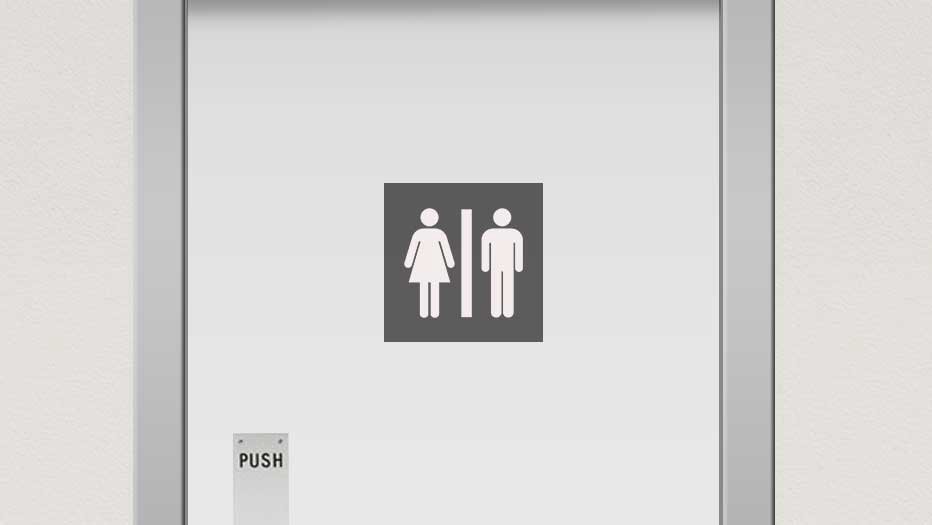
How have designers responded?
Given the need for change, designers have produced variations or adaptations of the existing symbol.
A merged form of the Man|Woman symbol has found the most popularity in recent years. It often appears with the woman and man, but can also stand alone. Adapting the familiar visual language of the standard pictographs minimises confusion: this is clearly a restroom. But this design is trapped in the construct of the original symbol. A few signs show only the top half of the pictograph, representing a non-gendered person. A less common alternative is to use the universal abstract gender ideographs. While these avoid pictorial representations of gender stereotypes, they are not as easy to identify as a pictogram. They are also used to signify gender in contexts outside of the restroom and so are not as readily identified as ?restroom? symbols.
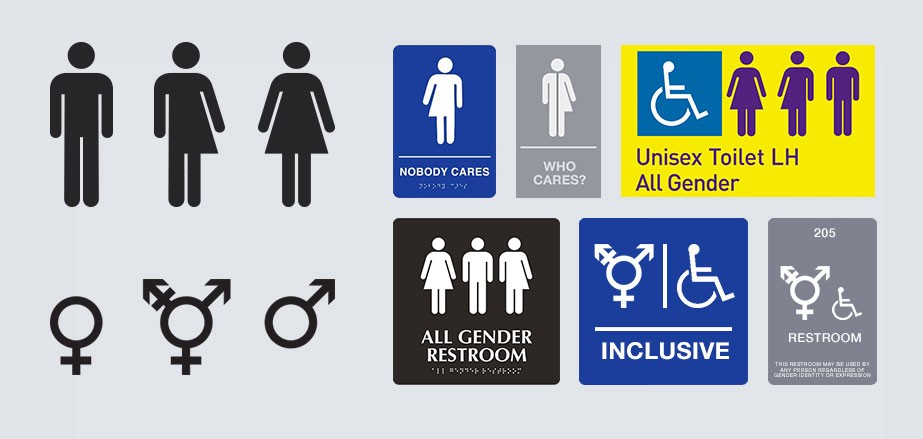 Gender pictograms and abstract ideographs, with the merged pictogram and transgender symbol (left), as seen on existing designs (right)
Gender pictograms and abstract ideographs, with the merged pictogram and transgender symbol (left), as seen on existing designs (right)
In some cases, the archetypal man and woman are joined by mermaids, unicorns or aliens. These playful and impertinent designs are a kind of graphic defiance; a rejection of the status quo. But they are not intended as universal symbols.
The pride rainbow has appeared on alternative designs for restroom signage. In this context it is used to represent gender diversity and inclusivity. Understanding its meaning requires a degree of social awareness. The symbol also represents many other concepts. And it raises technical challenges because it cannot be be rendered in a single colour.
 The colours of the most common version of the pride flag (designed by Gilbert Baker)
The colours of the most common version of the pride flag (designed by Gilbert Baker)
So long as bathrooms are politicised spaces, these designs serve an important purpose. But rather than co-opt them for a universal symbol, perhaps it?s best to let these designs continue to be what they are: symbols of identity, resistance and pride.
Alternatives to Gender
To move away from gender as the symbol for the restroom, some designers have tried using pictograms of the toilet. This type of sign can be effective when viewers are familiar with the kind of toilet the designer has depicted.
 Restroom symbols for signage in healthcare facilities (Designed for the Canadian Standards Association by Entro)
Restroom symbols for signage in healthcare facilities (Designed for the Canadian Standards Association by Entro)
But, depending on the place and the need, a person might be standing, sitting or squatting on one of many styles of toilet.
People around the world use many different kinds of toilets. Thus, pictograms of toilets aren?t ideal candidates for a universal restroom symbol.
A universal restroom symbol should be sensitive to the delicate nature of the subject. In polite language we tend to avoid direct references to the toilet, preferring euphemisms such as restroom, washroom, bathroom or even powder room. Visual language is no different: a pictogram of a toilet would likely be considered too direct for many contexts.
 Pictograms of toilets do make sense where squat or pedestal toilets are found together in a restroom; these are the JIS standard symbols for ?Western? and ?Japanese? toilets, used on cubicle doors in Japan
Pictograms of toilets do make sense where squat or pedestal toilets are found together in a restroom; these are the JIS standard symbols for ?Western? and ?Japanese? toilets, used on cubicle doors in Japan
Some designers have used toilet pictograms in an attempt to shift the emphasis away from gender. But it is possible to shift the focus from gender without abandoning the person. We can instead focus on our shared experience.
A shared experience: Washing our hands
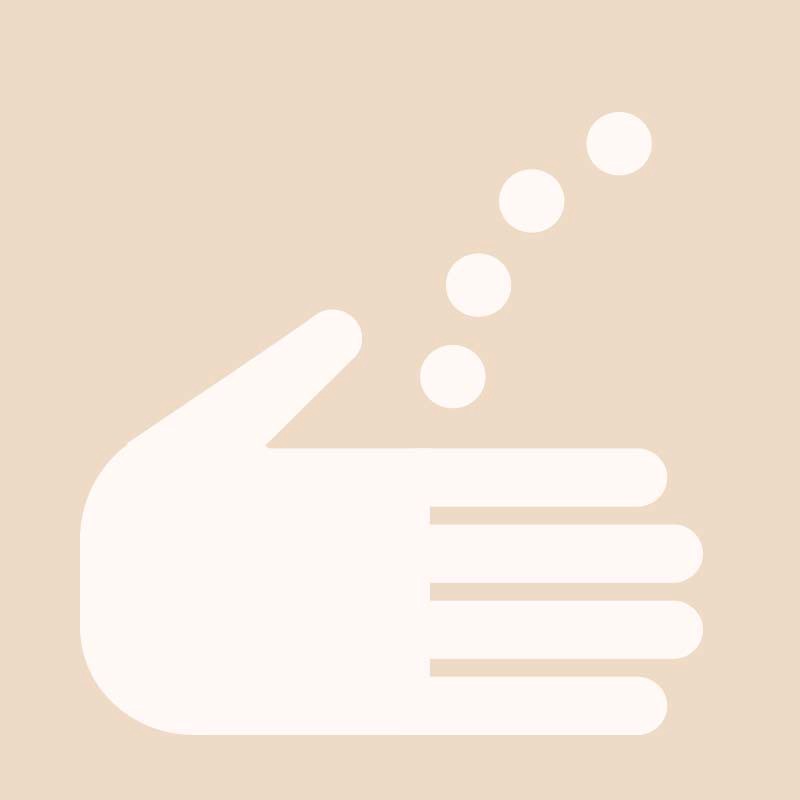
A universal symbol can be clearer and more inclusive when it represents everyone. When visiting the restroom there?s one thing that is common to every culture and gender: washing our hands.
A hand-wash symbol is a good candidate for a universal restroom symbol. It is a simple pictogram, rather than an abstract ideogram. It is sensitive to the delicate subject nature, but linked to a basic restroom action.
Symbols create associations between ideas, places and actions. The existing symbol links the restroom to gender. This new symbol teaches that the restroom is inherently linked to a behaviour that improves public health.
Design Challenges
Any symbol is not without its problems, and designing and introducing a new symbol comes with challenges.
A universal symbol should be exceptionally legible and understood effortlessly. It should be a harmonious member of the family of standard symbols. It should be easy to identify by touch on tactile signs for blind people.
Abstracting an action or a concept to its most essential elements poses questions: how little can be represented? What form is the most representative?
Taps come in all shapes and sizes, but a simple symbol can leave them out completely. The question of how to represent a flow of water can be easily answered: the convention among standardised symbols is a dotted line.
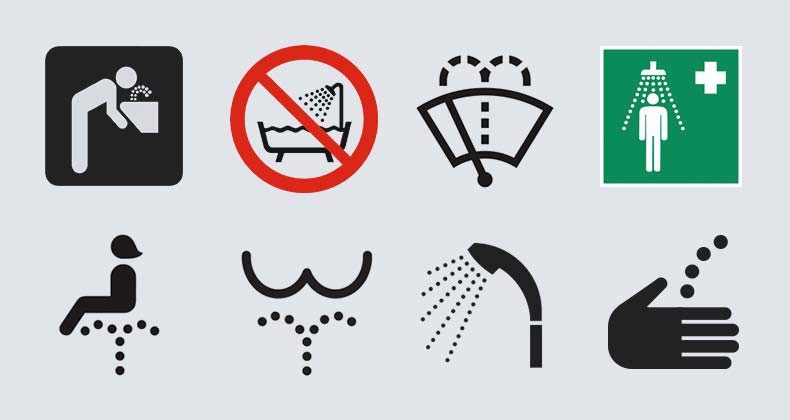 Examples of existing standard symbols featuring flowing water with the Restroom Symbol.
Examples of existing standard symbols featuring flowing water with the Restroom Symbol.
Hand-washing symbols are already used to indicate a place for hand-washing in hospitals, labs and kitchens. So we would need to differentiate the two symbols.
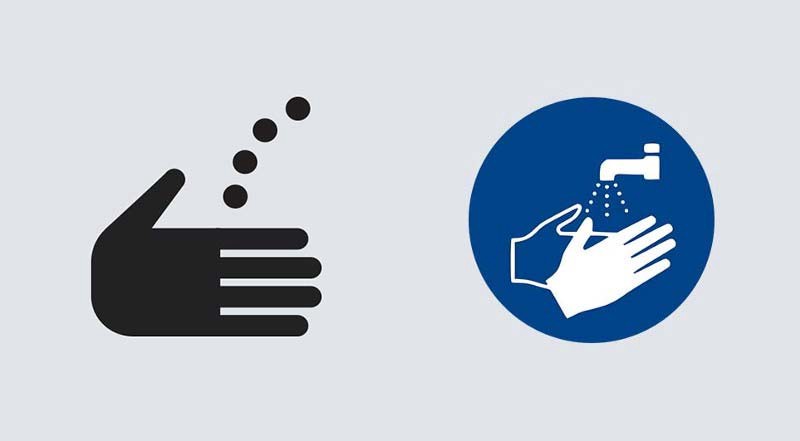 The Restroom Symbol (left) and an existing hand-washing symbol (right) are very similar
The Restroom Symbol (left) and an existing hand-washing symbol (right) are very similar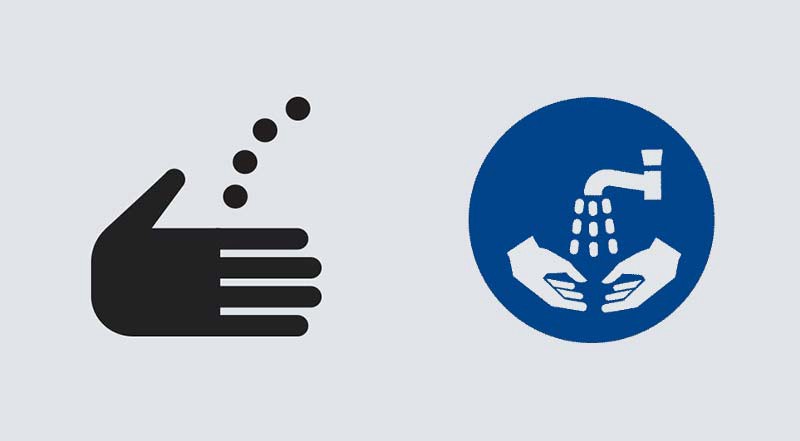 Another existing hand-washing symbol (right) is front-on with two hands, making it more distinct
Another existing hand-washing symbol (right) is front-on with two hands, making it more distinct
Changing a fundamental part of everyday life inevitably causes a degree of disruption. But if it?s well managed, like the switch to decimal currency or metric measurements, the lasting improvements to our daily lives justify the transitional speed-bump. The symbol can be gradually and thoughtfully introduced: at first, text labels can indicate the meaning; after the symbol has become more widespread and familiar, it can stand alone. Another approach is to use a transitional symbol that combines old and new. In any case, the old symbol is not immediately scrapped, but gradually retired as the new symbol becomes familiar. There?s no need for a sudden globally coordinated ?switch-over.?
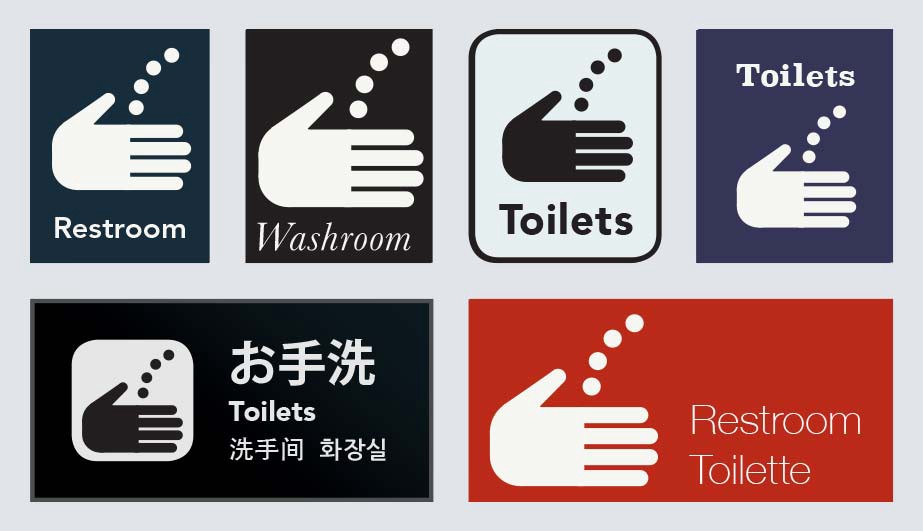 Various styles of the Restroom Symbol with text labels that teach the meaning of the new symbol
Various styles of the Restroom Symbol with text labels that teach the meaning of the new symbol A design for a transitional symbol (centre): the Man|Woman symbol is smaller, suggesting it is receding and is less important
A design for a transitional symbol (centre): the Man|Woman symbol is smaller, suggesting it is receding and is less important
And now?
Change in visual language, as in any language, isn?t effected from the top down. Change is cumulative; it happens sign by sign. This symbol is in the public domain and completely free to use, share or adapt in any way. If you use it or make your own version of it I?d be very happy to hear about it. If you?re trans, gender non-conforming, or face gender or sex discrimination, I?d like very much to hear your thoughts. Wherever it ends up, I hope this pictogram prompts reflection on the symbols we use and the effects they have.
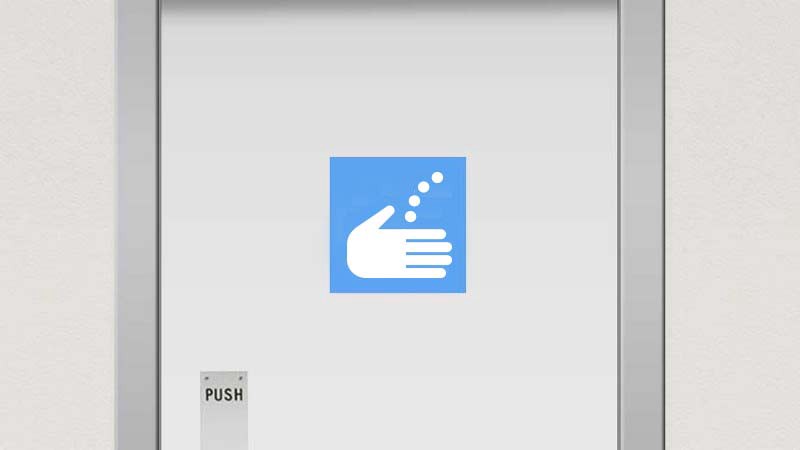
Bibliography
Ball, Aimee Lee (2015) In All-Gender Restrooms, the Signs Reflect the Times, New York TimesCastricum, Simona (2018) Public bathrooms are gender identity battlefields. What if we just do it right? The GuardianDobson, Saeri Cho; Dobson, Terry (2017) Tip of the Icon: Examining Socially Symbolic Indexical Signage (Dialectic, Volume I, Issue 1)Entro (2016) Inclusive Washrooms: a solution through signageGlancey, Jonathan (2014) The Genius Behind Stick Figure Toilet Signs BBC FutureJames, S. E., Herman, J. L., Rankin, S., Keisling, M., Mottet, L., & Anafi, M. (2016). Executive Summary of the Report of the 2015 U.S. Transgender Survey. Washington, DC: National Center for Transgender Equality.Miller, Shauna (2014) Public Bathrooms Are Gender Battlegrounds, Mostly Due to Terrible Signage Citylab


